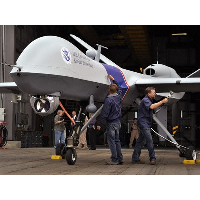Homeland Security Audit Says Costly Border Drones Don’t Do Much

The press release (pdf) from the Department of Homeland Security’s Office of the Inspector General (OIG) made no attempt to soft-pedal his findings about the U.S. Customs and Border Protection’s (CBP) newest weapon deployed along the Mexican border. It was entitled: “CBP Drones Are Dubious Achievers.”
The 8-year, $500 million program employs nine Predator B drones to patrol 1,993 miles of border along California, Arizona and Texas. A tenth ditched in the ocean near San Diego a year ago. The inspector general’s audit found the program was wildly expensive, there was “little or no evidence” of its effectiveness and its administration shoddy.
The drones, which are looking for illegal border crossings, rarely fly. The Border Patrol planned to fly the drones every day for 16 hours, but were operational just 22% of the time. They calculated that the cost of operating the drones was $2,468 per hour but the inspector general found the real cost was $12,255 an hour. The Border Patrol had failed to account for equipment, overhead and salaries for operators.
Although the drone program has been touted as covering the entire Southwest border, most of the patrols have occurred along 100 miles of Arizona and 70 miles of Texas. Drones were credited with contributing to less than 2% of border apprehensions. Each drone costs around $18 million.
“So if you do the math on that, it’s about $27,000 per apprehension, which seems like a lot of money,” DHS Inspector General John Roth told CBS News.
The Border Patrol disagrees. “CBP has achieved or exceeded all relevant performance expectations,” Office of Administration Assistant Commissioner Eugene H. Schied wrote in response to the report. He also argued that the report was incorrect to say the drones “were not operating along the entire southwest border” because they had the authority to patrol the entire stretch and, at one time or another, had actually done it.
The agency has another $433 million to buy 14 more drones, but the OIG cautioned against that. “Given the cost of the Unmanned Aircraft System program and its unproven
effectiveness, CBP should reconsider its plan to expand the program,” the report concluded. The audit said the money could be better spent using manned aircraft and surveillance technology on the ground.
Schied denied that the agency planned to procure more aircraft and gave drones credit for seizures of contraband that the inspector general’s report did not include. The only example of a border drug bust he gave credited the program with seizure of 49,447 pounds of marijuana in fiscal year 2013.
The drone issue may come up in Congress over the next few months. As part of budget negotiations last year, and partially in response to President Obama’s executive action on immigration, lawmakers put off final settlement of Homeland Security funding, which runs out in February.
–Ken Broder
To Learn More:
"No Evidence" Costly Drones Help Secure Border, Inspector General Says (by Kitty Felde, KPCC)
Homeland Security Drone Program Not Justifying Expense, Says Study (by Jeff Peques, CBS News)
Border Drones Are Ineffective, Badly Managed, Too Expensive, Official Says (by Brian Bennett, Los Angeles Times)
U.S. Surveillance Drones Largely Ineffective Along Border, Report Says (by Craig Whitlock, Washington Post)
Border Patrol Set to Weaponize Drones (by Noel Brinkerhoff, AllGov)
U.S. Customs and Border Protection's Unmanned Aircraft System Program Does Not Achieve Intended Results or Recognize All Costs of Operations (Department of Homeland Security Office of Inspector General (pdf)
- Top Stories
- Controversies
- Where is the Money Going?
- California and the Nation
- Appointments and Resignations
- Unusual News
- Latest News
- California Forbids U.S. Immigration Agents from Pretending to be Police
- California Lawmakers Urged to Strip “Self-Dealing” Tax Board of Its Duties
- Big Oil’s Grip on California
- Santa Cruz Police See Homeland Security Betrayal in Use of Gang Roundup as Cover for Immigration Raid
- Oil Companies Face Deadline to Stop Polluting California Groundwater





